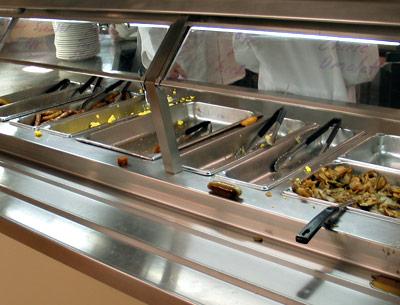Seasons by the Sea: College Food, a Lesson Plan

Parents, if you send your boys and girls off to college without having educated them on nutrition or taught them some rudimentary cooking skills, I can assure you, they will flounder. They will very likely live on ramen noodles and pizza (boys) and/or yogurt and cottage cheese (girls).
When I attended Kenyon College many years ago, all students lived on campus and had to survive on the meal plan. The meal plan provider was a company called Saga. Saga had four levels of food service meal plans, A, B, C, and D. The A and B levels were probably for well-to-do corporations. The C and D levels were for prisons and mental institutions and . . . Kenyon. There were no other choices in tiny Gambier, Ohio, other than a mediocre pizza parlor and the Village Inn, a charming little place that was famous for its glutinous cheese soup. A lot of us merely survived on a ghastly concoction of cottage cheese with granola, honey, and peanut butter smushed into it. I gained 20 pounds.
The kinds of foods available on college campuses sparked my interest recently when I spent four days in New Haven, Conn. In general, New Haven is a very depressed city, full of empty storefronts and panhandlers. In the midst of this is the glorious campus of Yale University. Surely such a fine Ivy League college would offer all kinds of healthy options, have plenty of grocery stores and affordable ethnic restaurants. Sadly, not so. Pizza is everywhere, noodle shops have proliferated, and for some reason, there are four or five Thai restaurants in a two-block radius. Since I was carless, I explored all the dining options I could on foot, as I assume most students have to. I sought out many restaurants, dives, and local specialties that were recommended by students.
Some were spectacular (the mashed potato pizza at BAR) and some god-awful (the Lithuanian coffee cake smothered in sugary frosting and denser than cement offered at a coffee shop).
After polling numerous friends on Facebook, I learned that many of us had to get very creative in our search for sustenance during our college years. My godmother Mary, Stanford, class of 1942, ate cottage cheese with jelly, Terrell swirled Sanka coffee powder into soft-serve vanilla ice cream. Eileen recalls pinto bean loaf and Justin remembers millet casserole. One of my Kenyon classmates would consume five glasses of milk and a slice of chocolate cake after soccer practice, followed by 10 p.m. pizza. There were quite a few grits horror stories, obviously submitted by Yankees who were down South for the first time in their lives, poor dears. And a few were lucky: Doug lived off the Berkeley campus right near Chez Panisse, and Tom went to the Culinary Institute of America.
When my son attended McGill in Montreal, it took him a while to take advantage of the 10-percent discount offered by the grocery store one day a week. As the drinking age is 18 in Canada, he was more intent on stocking the Madmen-James Bond-esque bar he had set up than the refrigerator. But he caught on eventually, figuring out that cooking up big stir fries and pots of rice would provide a few days worth of meals, that frozen vegetables were okay, and two good knives are all you really need.
If you are about to send a child off to school or they are already on their own, here are some suggestions to help them navigate the world of “cooking and eating on your own.” Give them a blender. Nowadays kids are inclined to make healthy smoothies. Give them a jar of protein powder to go with it. Give them a big frying pan and two good knives, making sure they know how to use them! A paring knife and chef’s knife should be enough. A big salad bowl can be a hint to eat right. Make sure they take advantage of the discounts at grocery stores and coffee shops and restaurants that are always available to students in college towns. A copy of “The Joy of Cooking” and perhaps an easy casserole cookbook will help make cooking on their own less daunting. If your children are forced to subsist on their school’s meal plan, hopefully they have learned how to make balanced meal choices.
Temptations are everywhere when a kid goes off to school. At Yale, there is a place called Insomnia Cookies. They open at noon and deliver cookies until 3 a.m. Can you imagine the delight of hard-studying students and stoners at this discovery? The Chinese restaurants run the gamut from pretty good to dreadful. Ivy Noodle, a real hole in the wall, had delicious, cheap broth soups full of fat noodles, but my takeout from Royal Garden was doughy, greasy dumplings with no filling and fried mystery meat smothered in orange sauce.
So while your kids are away at school getting an education, make sure they are also learning the life skills they will need forever — eating right and economizing.
Click for recipes
